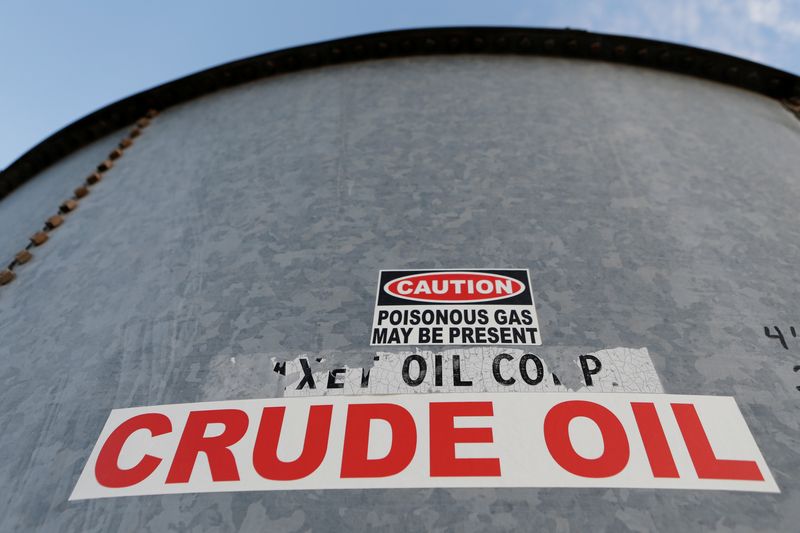Commodities
Oil falls after U.S. stockpiles climb, Middle East tensions in focus


© Reuters. FILE PHOTO: A sticker reads crude oil on the side of a storage tank in the Permian Basin in Mentone, Loving County, Texas, U.S. November 22, 2019. Picture taken November 22, 2019. REUTERS/Angus Mordant/File Photo
By Ahmad Ghaddar
LONDON (Reuters) -Oil prices fell on Thursday after a rise in stockpiles and a climb in the , giving up some ground gained a day earlier when prices jumped on fears of a broader conflict in the Middle East.
futures declined by 80 cents, or 0.9%, to $89.33 a barrel at 1010 GMT. U.S. West Texas Intermediate crude futures eased 91 cents, or 1.1%, to $84.48 a barrel.
The benchmark oil contracts had settled nearly 2% higher on Wednesday but fell back after the Wall Street Journal reported that Israel has agreed to delay an expected invasion of Gaza for now.
“The movements of oil markets are primarily involved with the Hamas-Israel war,” said Tina Teng, markets analyst at CMC.
U.S. crude inventories also rose in the latest week, indicating weak demand.
Inventories climbed by 1.4 million barrels to 421.1 million barrels, according to the Energy Information Administration, exceeding a 240,000-barrel gain expected by analysts from a Reuters poll.
Refinery crude runs in the U.S. fell by 207,000 barrels per day, while refinery utilisation rates also edged lower by 0.5 percentage point to 85.6% of total capacity, EIA data showed.
Macroeconomic concerns continued to weigh on the outlook for oil demand after a surprise downturn this month in euro zone business activity data.
“Though with no clear signs the war will spiral, attention is returning to volatile swings in the U.S. bond market and the broader fragile state of the world economy, that is unsettling investors,” MUFG analyst Ehsan Khoman said.
The European Central Bank (ECB) will likely keep interest rates unchanged at a record high when it meets later on Thursday, snapping a 15-month streak of hikes, but may discuss a quicker reduction of its oversized portfolio of government debt as it battles still excessive inflation.
TotalEnergies (EPA:) on Thursday said fuel demand growth this year of about 2 million barrel per day (bpd) was driven by emerging countries, notably due to a recovery in the aviation sector and demand from China’s petrochemical industry.
Commodities
Oil prices rise; U.S. crude inventories plunge, Russia-Ukraine truce eyed
Commodities
India’s Reliance to stop buying Venezuelan oil over US tariffs, sources say
Commodities
Oil prices climb on Venezuela supply worries

 Forex3 years ago
Forex3 years agoForex Today: the dollar is gaining strength amid gloomy sentiment at the start of the Fed’s week

 Forex3 years ago
Forex3 years agoUnbiased review of Pocket Option broker

 Forex3 years ago
Forex3 years agoDollar to pound sterling exchange rate today: Pound plummeted to its lowest since 1985

 Forex3 years ago
Forex3 years agoHow is the Australian dollar doing today?

 Cryptocurrency3 years ago
Cryptocurrency3 years agoWhat happened in the crypto market – current events today

 World3 years ago
World3 years agoWhy are modern video games an art form?

 Commodities3 years ago
Commodities3 years agoCopper continues to fall in price on expectations of lower demand in China

 Economy3 years ago
Economy3 years agoCrude oil tankers double in price due to EU anti-Russian sanctions



























